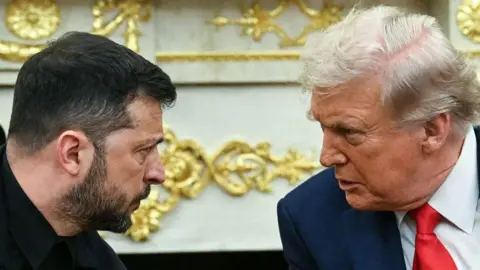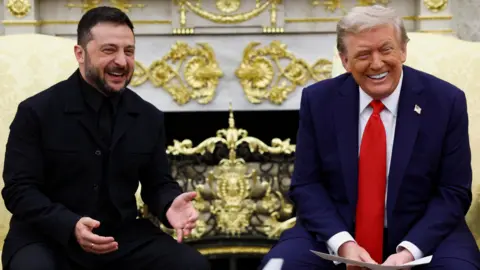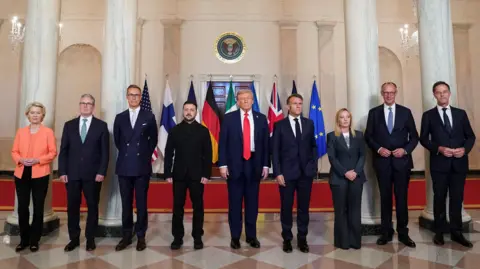Reporting from the White House
 Getty Images
Getty ImagesUkraine’s President Volodymyr Zelensky returned to the White House on Monday to meet US President Donald Trump for fresh talks aimed at ending the war in Ukraine.
Several European leaders also upended their plans to attend the meeting, days after Trump met Russia’s President Putin in Alaska for a summit that failed to yield a ceasefire.
Here are the key takeaways from the talks in Washington.
Zelensky launches charm offensive
Given his acrimonious last visit to the Oval Office in February, the Ukrainian president went to considerable lengths to be collegial and charm his American hosts – including a flurry of six “thank yous” within the first few minutes of the meeting.
The last time he was at the White House, Zelensky was scolded by Vice-President JD Vance for a perceived lack of gratitude for US support for Ukraine during the war.
Another point of contention in February’s meeting – Zelensky’s attire – also made a return.
This time, Zelensky was dressed in a dark suit rather than his traditional military garb, and appeared well prepared with a joke when asked about his outfit by the same reporter who had previously criticised him for not wearing a suit to the Oval Office.
After the reporter told him that he looked “fabulous”, Zelensky shot back that he was wearing the “same suit” as last time, eliciting laughter from the reporters, Trump and other officials in the room.
“As you see, I changed,” he added.
 Reuters
ReutersZelensky also sought to play to Trump’s family during the meeting, handing the US president a letter from Ukrainian First Lady Olena Zelenska to be delivered to Melania Trump.
“It’s not to you — to your wife,” he said.
The delivery of the letter comes just days after Trump hand-delivered a letter from Melania to Vladimir Putin while in Alaska, in which she called on Putin to protect “the innocence” of children and “nurture the next generation’s hope”.
“She sees the heartbreak,” Trump said of his wife’s letter to Putin.
“She would love to see it end. And she says it very openly, very proudly, and with great sorrow, because so many people have been killed.”
Trump hints at security guarantees
One of the questions put to Zelensky was about what he would need from the US to guarantee his country’s security. Was it troops, intelligence, equipment?
In a moment that conveyed the sense of urgency he seemingly tried to suppress throughout much of the press conference, Zelensky leaned forward in his chair and said, emphatically: “Everything.”
“We need a strong Ukrainian army,” he added. “It’s about weapons, people, training missions and intelligence.”
Pressed on this by reporters, Trump made several references to security guarantees for Kyiv.
He said that Europe would be the “first line of defence” for Ukraine but promised to also be “involved”.
“We’ll give them good protection,” the president said at one point.
This is the most decisive Trump has ever sounded on the issue of security guarantees, which are generally seen as paramount to any sort of deal with Russia.
On Monday, the US president said that during last week’s Alaska summit Putin had accepted that there would be security guarantees for Ukraine as part of any peace deal.
But the lack of detail on what exactly these guarantees might consist of is concerning to both Kyiv and Europe, and behind closed doors leaders will no doubt try to impress on Trump that the US deterrent needs to be more than just symbolic.
A continued flow of weapons to Ukraine would be welcome; a promise of American boots on the ground would be even more consequential.
Such a level of commitment may be difficult to obtain, at this stage, from the US.
But the fact that Trump did not rule it out altogether will be giving Ukraine and its allies hope that he could be persuaded.
A trilateral meeting on the cards?
One of Trump’s much-touted objectives is to organise a three-way meeting with Zelensky and Putin.
Before his talks with European leaders on Monday, he said it was now a matter of “when, not if” such a meeting would take place.
While this may be an easier endeavour than defining the terms of a peace deal, it will by no means be straightforward.
 Reuters
ReutersFor months, Zelensky has been pushing to meet Putin. This was likely a way of proving his argument that Russia is not serious about pursuing peace, as he knew that Putin had no interest in agreeing to a meeting of this sort.
Indeed the Kremlin has repeatedly turned this down and two weeks ago argued that the Russian and Ukrainian presidents had no reason to meet until “after the appropriate distance” between the positions of the two countries is “overcome”.
Trump will be hoping that distance is now being bridged by his mediation efforts.

